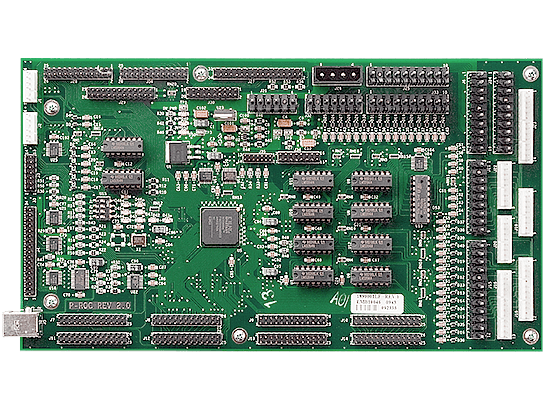How to configure switches (P-ROC)
Related Config File Sections:
To configure switches on a P-ROC, you can follow the guides and instructions in the Switches docs.

However there are a few things to know about using switches with a P-ROC.
number:
Switches are directly connected to the P-ROC board itself. There are two types of switches---matrix and direct---and they each have a different number format.
Note
If you're using your P-ROC in an existing machine, then don't use the number settings here. Instead use the numbers from the existing machine section of the documentation.
Direct Switches
The P-ROC has 32 direct switch inputs (which are switches that are directly connected to the P-ROC that do not require a switch matrix). Direct switches are numbered 0-31. (See the P-ROC documentation for the connector mappings.)
Direct switches are configured in your machine config file by starting the number with "SD", like this:
switches:
my_switch:
number: SD0
my_other_switch:
number: SD1
another_switch:
number: SD12
Matrix Switches
If you're using a switch matrix, then the switch numbers are entered using the column number, then a slash, then the row number.
switches:
my_switch:
number: 0/0 # column 0, row 0
my_other_switch:
number: 0/1 # column 0, row 1
another_switch:
number: 3/4 # column 3, row 4
Mixing and matching direct and matrix switches
You can mix-and-match direct and matrix switches. However you should be aware of the hardware limitations of combining both. The P-ROC gives you the ability for ONE of the following:
- 32 direct switches and an 8x8 (64 switches) matrix
- 24 direct switches and an 8x16 (128 switches) matrix
Basically the P-ROC has the ability to repurpose 8 of the direct switch inputs as row inputs to extend the switch matrix from 8 to 16 rows. This means that valid values are:
- Direct switches,
SD0-SD31 - Matrix switches,
0/0-7/7
OR
- Direct switches,
SD8-SD31 - Matrix switches,
0/0-7/15
In other words, if any switch uses a row number (the number after the slash) greater than 7, then you can't use direct switches 0 through 7.
The configuration of this is automatic based on the numbers you use, but currently there is no error checking to ensure that SD0 - SD7 are not used if you have any switch which a row that's 8-15.
Choosing direct versus matrix switches
The only difference between direct and matrix switches is in how they're wired. Matrix switches use less wire, but require diodes on the switches and are harder to troubleshoot. Direct switches are easier to wire, but they require more wire and you're limited to 24 (or 32) of them.
If you're using opto switches then you must connect the IR receivers to direct switch inputs, since the direct switch inputs are always powered.
There's a misconception that direct switches are "faster" than matrix switches. That is false. The P-ROC scans the 8 columns of the matrix (one at a time), then it reads the direct switches, then the matrix switches again, then the directs, etc. So from a practical sense, the directly switches are really like a single column matrix with either 24 or 32 rows, and they're scanned after the rows of the matrix are scanned. So whether a switch is direct or in the matrix doesn't affect the scanning speed or response time of the switch.
Debounce options
The P-ROC has the ability to configure debounce settings for switches. A non-debounced switch which report its state change immediately, while a debounced switch will report its state change after it's been in the new state for two consecutive reads.
By default, MPF will enable debouncing in both directions (open and
close) for all switches. However you can override this on a per-switch
basis with a switch's debounce: setting.
Valid options are normal, quick, and auto.
To disable debouncing for a switch, add debounce: quick to the switch
config, like this:
switches:
my_switch:
number: 0/0
debounce: quick
To force debouncing to always be used (which is also the default on the P-ROC, so not really needed), configure it like this:
switches:
my_switch:
number: 0/0
debounce: normal
What if it did not work?
Have a look at our troubleshooting guide for the P/P3-Roc.
Something missing or wrong? You can fix it!
This website is edited by people like you! Is something wrong or missing? Is something out of date, or can you explain it better?
Please help us! You can fix it yourself and be an official "open source" contributor!
It's easy! See our Beginner's guide to editing the docs.
Page navigation via the keyboard: < >
You can navigate this site via the keyboard. There are two modes:
General navigation, when search is not focused:
- F , S , / : open search dialog
- P , , : go to previous page
- N , . : go to next page
While using the search function:
- Down , Up : select next / previous result
- Esc , Tab : close search
- Enter : go to highlighted page in the results